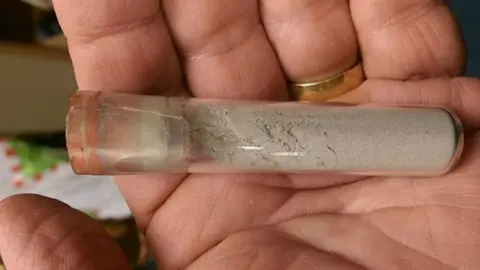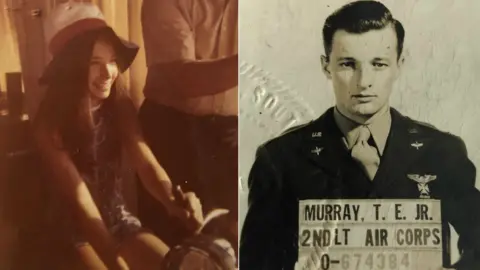Woman sues Nasa over ownership of moon dust vial
 Courtsey Laura Cicco
Courtsey Laura CiccoA Tennessee woman is suing the National Aeronautics and Space Administration (Nasa) over a vial of moon dust.
Laura Cicco claims in a federal lawsuit that astronaut Neil Armstrong gave the vial to her parents when she was just 10 years old.
Nearly 50 years later, Ms Cicco filed the lawsuit out of fear that Nasa will attempt to confiscate the moon dust from her.
Private ownership of lunar material is a contentious legal issue in the US.
The lawsuit claims that test results have authenticated Ms Cicco's vial, although some experts still have questions.
If the initial findings are replicated, the vial would be extremely valuable but legally hazardous to sell.
"Nasa has taken this position that all lunar material is government property," says Christopher McHugh, Ms Cicco's lawyer.
"They've done Swat-style raids on people who have this stuff, treating them like criminals. I didn't want that to happen to Laura."
In 2012, Congress passed a law that said that if astronauts took "artefacts" home with them from their space missions - such as flight manuals, personal logs or jettisoned pieces of their lunar modules - the items belonged to them and the federal government would not attempt to claim ownership.
However, it specifically exempted "lunar rocks and other lunar material".
A spokeswoman for Nasa declined to comment on the lawsuit or clarify their position on private ownership of lunar material.
How did she acquire the moon dust?
In 1972, Ms Cicco says that her father, Tom Murray, came home from work one day and handed her a vial of grey powder.
Her mother Dorothy explained that it came from the first man to ever walk on the moon, Neil Armstrong, and also showed her his signature on the back of one of her father's business cards.
"To Laura Ann Murray, best of luck, Neil Armstrong, Apollo 11," the card read.
According to Ms Cicco, her father and Mr Armstrong were both members of a Cincinnati chapter of the Quiet Birdmen, a secret society of prominent aviators founded in the 1920s.
The two men were apparently close enough that Mr Armstrong gave Mr Murray a gift for his young daughter.
But at 10 years old, Ms Cicco did not understand what she held in her hand.
"I wasn't really excited about it," she recalls.
Decades later, Ms Cicco found the vial wrapped in a paper towel in between her mother's quilts while sifting through her late parents' belongings.
Although she had Mr Armstrong's autograph in a frame for years, she had completely forgotten about the moon dust.
 Courtesy Laura Cicco
Courtesy Laura CiccoIt wasn't until Ms Cicco and her husband Chris tried to get the contents of the vial tested that they realised they might have a problem on their hands.
"[I tried] a couple universities. The minute they found out what we thought it was they just said they don't want to mess with it because they don't want to get in trouble," says Mr Cicco.
Can private citizens own moon dust?
The lawsuit disagrees with Nasa's assertion that all lunar material belongs to the government, claiming that in the absence of a law explicitly banning private ownership, Ms Cicco should be allowed to keep hers.
Mr McHugh says the 2012 law created a "loophole" for lunar material that this case would attempt to close.
"There is no law against private persons owning lunar material," the lawsuit reads. "Lunar material is not contraband. It is not illegal to own or possess."
However, Joseph Gutheinz, a former senior special agent for Nasa's Inspector General who led the first undercover mission to return a stolen lunar rock in the late 1990s, disagrees, saying that even if Ms Cicco's vial is authentic, the government may still have a claim to her moon dust.
"Lunar dust and lunar rocks that are brought back by an Apollo mission are the property of the United States government unless they give it to a foreign government," he says. "Neil Armstrong wouldn't have had authority to give the moon rock away."
Mr McHugh says that if Nasa were to take that position, they would essentially be calling one of the "greatest American heroes in history a thief".
Has Nasa seized lunar material before?
Nasa has acted several times to reclaim moon rocks that landed in the hands of private citizens.
One of the most contentious cases occurred in 2011, when Joann Davis, the widow of a former Nasa engineer, attempted to sell two Lucite paperweights given to her by her late husband - one containing a rice grain-sized piece of lunar rock, the other with a piece of the Apollo 11 heat shield.
Ms Davis and her new husband met the "buyer" at a Denny's Restaurant, only to discover it was a sting operation lead by Nasa's Inspector General.
The federal agents believed the 74-year-old had stolen the artefacts (she was never charged and successfully sued the agents).
 Courtesy Laura Cicco
Courtesy Laura CiccoMr McHugh has also represented another client who bought a priceless lunar sample bag which was mistakenly put up for auction after it was confiscated from a space museum director who stole it from the collection.
Armstrong used the bag to collect the very first moon rock specimens in 1969, and it still contained trace amounts of lunar dust.
Because the bag was auctioned off accidentally by the government, a court eventually ruled after a protracted legal battle that Nasa could not have it back. The woman eventually sold it for $1.8m (£1.3m).
Theft of lunar material is a real problem - in 2002, three Nasa interns stole samples worth an estimated $21m from the Johnson Space Center in Houston.
Of the 270 lunar samples given as gifts by the US to foreign governments, about 150 are missing and many are presumed to have been sold on the black market.
But Mr McHugh says that people like Ms Cicco who can prove they did not steal the material should be allowed to own it without interference from Nasa. He hopes that by asking for a federal jury trial, the matter of whether or not private citizens may own lunar material will be decided once and for all.
At this point, Ms Cicco isn't sure what she will do with the vial if she's allowed to keep it, though it may be worth millions.
"It means more for my memory of my father," she says. "When I was a little girl, your father is your superhero. I'm just really excited for him."
